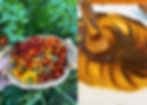Pigment Garden Ideas: 3 Beginner-Friendly Plants
- Mira
- Mar 31
- 4 min read
It's the season for seed-starting, and in honor of spring I'm introducing you to some of my favorite beginner-friendly pigment-rich plants! Though it can feel overwhelming to consider starting your own pigment garden, I'm here to tell you that you don’t need acres of land to grow your own color. Some of the most beautiful and satisfying pigment plants will happily thrive in a small raised bed, a tucked-away corner of your veggie patch, or even a handful of pots on a sunny porch.
Whether you’re a seasoned gardener or just starting out, growing your own pigment plants is a simple and deeply rewarding way to connect your creative process to the land. Here are a few of my favorite beginner-friendly plants for making color straight from the garden.
For Purple: Black Nebula Carrots
These carrots are just as magical as they sound. Their deep purple roots yield a surprisingly bold and satisfying pigment—and the best part? The carrots you don’t turn into paint are still absolutely delicious to eat. Black Nebula carrots are dual-purpose: food and color, all from the same garden bed!

Growing Tips:
Direct sow seeds outdoors as soon as the soil can be worked in early spring (Zone 5b–6a growers, think mid to late April).
Choose well-drained, loose soil to help the roots grow long and straight.
Thin seedlings early to give roots room to develop.
Harvest in the fall, just after the first frost.
Pigment tip: boil 3 cups shredded carrots with 3 cups water to extract their pigment. Strain liquid and add approximately a tablespoon of alum dissolved in a little hot water, then slowly add soda ash (also dissolved in a little hot water) until your solution is a neutral PH (7). Catch the pigment by straining through a coffee filter, then drying.
For Warm Yellow: Marigold Flowers (any variety)
Marigolds are a classic in any garden, but they do double duty here—keeping pests away from your veggies and offering you beautiful, warm yellow pigment when the season ends. The flowers smell like sunshine (especially when simmering to extract pigment) and give a soft, glowing yellow that has quickly become one of my staple colors. Experiment with variety--I've found that they all yield some version of warm yellow.

Growing Tips:
Start seeds indoors 4–6 weeks before your last frost or direct sow once the danger of frost has passed (late May for most Vermont gardens).
Marigolds thrive in full sun and tolerate a range of soil types.
Deadhead regularly for continuous blooming all summer.
Harvest flowers when fully open, ideally in the morning after the dew has dried.
Dry the blooms for future pigment-making or use them fresh.
Pigment tip: simmer approximately 3 cups dry or fresh marigold petals with 3 cups water to extract their pigment. Strain liquid and add approximately a tablespoon of alum dissolved in a little hot water, then slowly add soda ash (also dissolved in a little hot water) until your solution is a neutral PH (7). Catch the pigment by straining through a coffee filter, then drying.
For Blue: Japanese Indigo
Of all the plants I grow for pigment, Japanese indigo is by far the one I get asked the most about. From these unassuming green leaves comes one of the most iconic blues in art history. Even here in Vermont’s shorter growing season, I’ve found this variety of indigo to be surprisingly hardy—as long as you start early and grow in full sun. I've grown great patches of indigo in my patio garden boxes!

Growing Tips:
Start seeds indoors 6–8 weeks before your last frost (March or early April for Vermont).
Transplant into the garden after the danger of frost has fully passed and soil has warmed. In my experience the sprouts are pretty hardy and don't mind being transplanted.
Give indigo plants full sun and space to spread.
Harvest the leaves before the plant goes to seed for the richest color.
Pigment tip: Indigo is a joy to experiment with—you can use fresh leaves for dyeing fabric, or extracting pigment. While the extraction process is a bit more complicated, so I've written a separate post on the process of extracting indigo pigment.
You can find Japanese Indigo seeds at Grand Prismatic Seed — they’ve been my go-to for reliable, healthy plants. They have a whole section of other seeds for natural dyeing and if you want to try something not mentioned here...they are a great place to start!
Why Grow Your Own Pigment Garden?
For me, this is where painting begins—not in the studio, but in the soil. Growing pigment plants invites patience, attention, and wonder into your creative process. Whether you’re making ink, watercolor, or experimenting with pigment for the first time, starting from seed makes the color feel like yours in a way no art store tube ever could.
So even if you only have room for a few pots or one tucked-away bed, I encourage you to try it. Let me know if you do—I’d love to hear what colors you grow!
-Mira
Artist, Growing in Process
